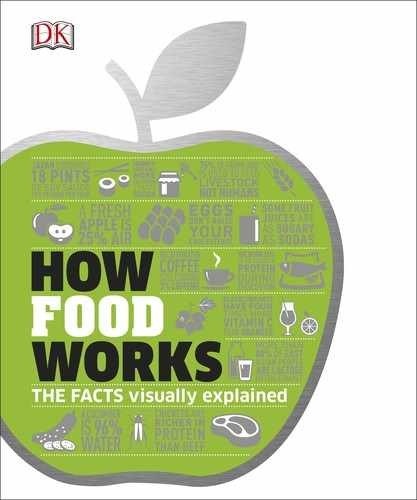
Fermentation
Used across the globe throughout history, fermentation
is a simple form of food preservation requiring no heat
or artificial energy source. In the absence of oxygen,
microbes can convert sugars into acids, alcohol, and gas.
Other foods that are fermented
In addition to helping to preserve foods, fermentation
can leaven dough through generating gas, and produce
browning reactions, adding color and flavor. Different
methods of fermentation are used in breadmaking;
alcoholic drinks and vinegar production; making
yogurts and cheeses; pickling fruit and vegetables;
curing meats; making soy and fish sauces; softening
olives and removing their bitterness; and producing
chocolate from cocoa beans.
Fermented milk
Milk has a very short
shelf-life, but fermented
dairy products can last
for months. These range
from yogurt and crème
fraiche, fermented for
just a few hours, to
large cheeses prepared
over many months.
Fermented cabbage
Sauerkraut, originating from Europe, is
one of the most popular preparations
of fermented cabbage.
MILK
YOGURT
CRÈME FRAÎCHE
CHEESE
IN THE 1700S FERMENTED CABBAGE
WAS USED BY SAILORS TO COMBAT
VITAMIN C DEFICIENCY AND SCURVY
Why do we ferment foods?
As microbes such as Lactobacillus thrive in an
oxgen-free environment, their success suppresses
the growth of spoilage microbes, generating
preservative by-products and interesting flavors.
Fermentation microbes are often the same as the
ones found in our gut, so eating fermented
food can be a good way to top up gut flora.
Water and sugars drawn
out of cells by salt
Teasing out the sugar
Salt helps to draw water and
cell contents (including sugars) out of
the plant cells, so that the fermenting
microbes can get to work.
2
Salted and soaked
Salt is applied as a brine,
cutting off oxygen supply to
competing microbes. The cabbage
must be kept below the surface.
1
SALTY WATER
WATER SUGAR
SHREDDED
CABBAGE
STORING AND COOKING
Fermentation
Salt
US_052-053_Fermentation.indd 52 23/02/2017 11:26
Pre-industrial societies used
fermentation to prevent spoilage
of fish, resulting in delicacies of
strong odor and flavor. Iceland’s
Hákarl is Greenland shark that has
been gutted and beheaded, buried
in a sandy pit and left to ferment
for six to 12 weeks before
being wind-dried, shaved,
and cut into small pieces.
ICELANDIC DELICACY
HÁKARL
Fermented cucumber
Cucumbers are turned into
pickles using lactic acid
bacteria and brine with
five to eight percent salt
concentration.
Fermented taro root
Rich in starch but toxic
when raw, taro are used in
Hawaii to make poi, a
fermented preparation rich
in flavorful volatile acids.
Fermented soy
Soybeans have high
levels of protein and oil,
which can be extracted
as a kind of milk. This is
fermented in a similar
fashion to milk and with
outcomes as equally
diverse—from the thick
miso paste used for
soups and seasoning
to tempeh, a cultured
soybean cake.
POITARO ROOT
CUCUMBER PICKLE
Fermentation
A succession of fermenting microbes consumes
the sugars, generating a complex mixture of alcohols,
acids, and flavor compounds. Fermentation also helps
to retain the nutritional value of the cabbage. The
layer of carbon dioxide gas protects vitamin C from
oxidation, while B vitamins are produced.
3
Flavor compounds
are released
Microbes
consume sugar
Bubbles of
carbon dioxide
SOY
SOY SAUCE
MISO
TEMPEH
Fermented result
The delicious and nutritious
sauerkraut is tart and crunchy. Yeast
growth is limited by the process, but
a little growth is acceptable and even
generates a distinct, flowery aroma.
4
SAUERKRAUT
FLAVOR
COMPOUND
SUGAR
MICROBE
52 53
STORING AND COOKING
Fermentation
US_052-053_Fermentation.indd 53 18/01/2017 09:42

Pre-industrial societies used
fermentation to prevent spoilage
of fish, resulting in delicacies of
strong odor and flavor. Iceland’s
Hákarl is Greenland shark that has
been gutted and beheaded, buried
in a sandy pit and left to ferment
for six to 12 weeks before
being wind-dried, shaved,
and cut into small pieces.
ICELANDIC DELICACY
HÁKARL
Fermented cucumber
Cucumbers are turned into
pickles using lactic acid
bacteria and brine with
five to eight percent salt
concentration.
Fermented taro root
Rich in starch but toxic
when raw, taro are used in
Hawaii to make poi, a
fermented preparation rich
in flavorful volatile acids.
Fermented soy
Soybeans have high
levels of protein and oil,
which can be extracted
as a kind of milk. This is
fermented in a similar
fashion to milk and with
outcomes as equally
diverse—from the thick
miso paste used for
soups and seasoning
to tempeh, a cultured
soybean cake.
POITARO ROOT
CUCUMBER PICKLE
Fermentation
A succession of fermenting microbes consumes
the sugars, generating a complex mixture of alcohols,
acids, and flavor compounds. Fermentation also helps
to retain the nutritional value of the cabbage. The
layer of carbon dioxide gas protects vitamin C from
oxidation, while B vitamins are produced.
3
Flavor compounds
are released
Microbes
consume sugar
Bubbles of
carbon dioxide
SOY
SOY SAUCE
MISO
TEMPEH
Fermented result
The delicious and nutritious
sauerkraut is tart and crunchy. Yeast
growth is limited by the process, but
a little growth is acceptable and even
generates a distinct, flowery aroma.
4
SAUERKRAUT
FLAVOR
COMPOUND
SUGAR
MICROBE
52 53
STORING AND COOKING
Fermentation
US_052-053_Fermentation.indd 53 18/01/2017 09:42
..................Content has been hidden....................
You can't read the all page of ebook, please click here login for view all page.
